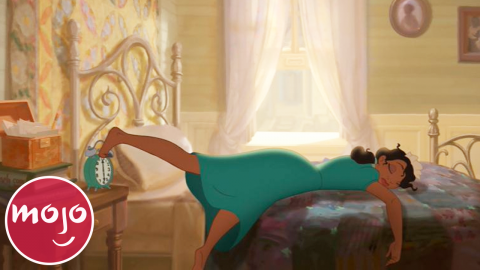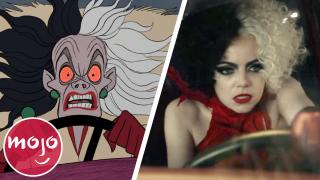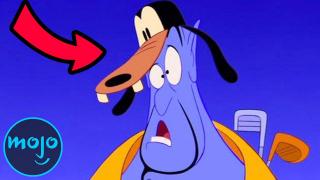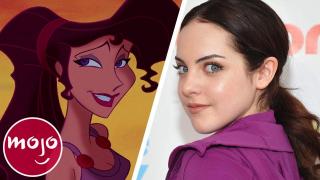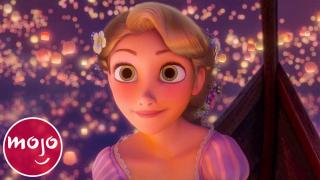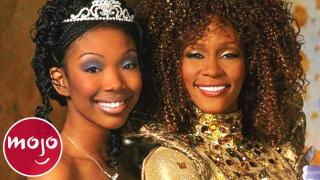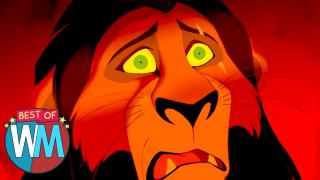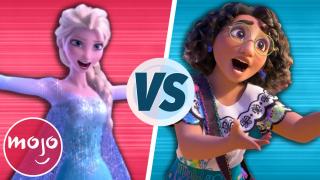Top 10 Times Disney Improved on the Source Material
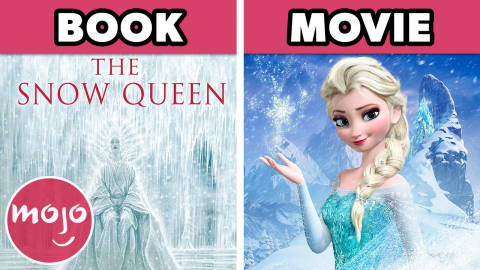
#10: “The Princess and the Frog” (2009)
“The Frog Prince” (1812)
Top 10 Most Relatable Disney Princess Moments
This classically animated story is a fun twist on its original source materials with significant changes in settings, characters and objectives. While based on the German fairy tale by the Brothers Grimm, the film is also inspired by a 2002 E. D. Baker novel. Unlike either version, Disney’s protagonist Tiana is not a princess but rather a hard working and aspirational young woman. Similarly to Baker’s story, she befalls the same fate as her royal frog acquaintance upon kissing him. The amphibian couple then embark on an adventure that differs vastly from the original tale or novel. The jazz inspired soundtrack reflects the distinctly American setting of New Orleans, something which further differentiates this film from others in the Disney Princess franchise.
#9: “Cruella” (2021)
“The Hundred and One Dalmatians” (1956)
The Evolution of Cruella de Vil
When seeking inspiration for a feature film, Disney turned to Dodie Smith’s children’s novel multiple times over the years. Their 1961 animated adaptation is a relatively faithful if simplified version of the original story. And in 1996, we got Disney’s first live-action interpretation of the story. Among the three aforementioned versions, Cruella is universally set upon killing dogs for their coats. It’s not until the 1996 film that she becomes more than just obsessed with fur, but also the owner of a house of fashion. The 2021 film elaborates on her love of fashion, developing her as a creative but misunderstood aspiring designer. A dog owner herself, this edition of the character is by far more complex and sympathetic than we’ve seen her before.
#8: “The Fox and the Hound” (1981)
“The Fox and the Hound” (1967)
Top 10 Times Disney Made Fun of Disney
While retaining many of the same elements as the 1967 American novel by Daniel P. Mannix, Disney’s animated retelling is by far more optimistic than its source material. The original story follows Copper and his master’s pursuit of Tod over many years in the name of avenging Chief’s death. While the two animals enjoy outsmarting one another and grow to appreciate the hunt, they lack the loyal relationship that’s found in the movie. Tod and Copper’s friendship in spite of their oppositional roles as fox and hound is Disney’s central theme. Not to mention the fact that Chief, Copper, Tod and his vixen mate all die in the book. We’ll take unlikely animal friends over that any day.
#7: “Hercules” (1997)
Heracles
Top 10 Stars We Need for the Live-Action Hercules Movie
Disney’s film inspired by the heroic demigod has little similarity with the traditional story told in Greek mythology. The hero’s conception by Zeus’s affair with a human is rewritten to be a more kid-friendly abduction of Hercules as an infant. It’s during this event he drinks the potion that turns him half mortal. Not even his name is technically correct, since “Hercules” is the name of Heracles’s Roman mythological counterpart. Inconsistencies aside, Disney’s story is a fun interpretation with elements of comedy, romance, and self-improvement. Not to mention the soundtrack is top tier. If nothing else, the muses qualify this film as an improvement.
#6: “Tangled” (2010)
“Rapunzel” (1812)
Top 10 Best Tangled Franchise Songs
Beginning with the exposition, this Disney adaptation deviates significantly from the fairytale recorded by the Brothers Grimm. In the original, Rapunzel’s peasant father steals from the neighboring sorceress’s garden in order to appease her mother’s pregnancy cravings. Their child is then claimed by the sorceress as retribution. However, the film presents Repunzel’s parents as royalty seeking a magical flower for its medicinal properties. Their child is then locked up by Mother Gothel while she’s still a baby. The changes only continue from there. Rapunzel’s love interest is a thief, not a prince, the action takes place mostly outside the tower instead of inside, and Rapunzel’s haircut ultimately liberates her. Overall, Disney’s movie has more likable characters and a story suited for contemporary times.
#5: “Cinderella” (2015)
“Cinderella or the Little Glass Slipper” (1697)
Top 10 Behind the Scenes Facts About Cinderella (1997)
A fairytale with thousands of variations, it's not surprising that Disney tried their hand at adapting this story more than once. While the animated film is admittedly iconic, we want to give props to the live-action version. Both Disney’s 1950 and 2015 retellings are based on the French story by Charles Perrault. The animated film incorporates many elements introduced by Perrault such as the Fairy Godmother, the pumpkin, and slippers that are made of glass. As an adaptation of the animation, the live-action version includes many of the same elements but isn’t afraid to make changes. The film explores its own plot, art style, and Fairy Godmother. In a mass of repetitive live-action adaptations of Disney classics, “Cinderella” distinguishes itself as different.
#4: “The Hunchback of Notre Dame” (1996)
“The Hunchback of Notre-Dame” (1831)
Top 10 Satisfying Villain Deaths in Disney Movies - Best of WatchMojo
In addition to being an ode to Gothic architecture, Victor Hugo’s novel tells a heart-wrenching tale. Disney’s adaptation, while dark compared to their other animated features, is a gentler retelling of Hugo’s original story. Both versions explore themes of prejudice, exploitation, and sin, but the movie retains a more positive outlook than its source material. In both versions, Quasimodo, Phoebus and Frollo share a common infatuation with Esmeralda. The original version doesn’t exactly present their feelings as wholesome, however. Frollo is definitely a huge creep in the movie, but the book really amps things up! In the end, nobody is able to save Esmeralda. Thankfully, Disney manages to tell a story that honors the source material while being much less depressing.
#3: “Frozen” (2013)
“The Snow Queen” (1844)
Encanto VS Frozen
Disney’s take on this tale by Hans Christian Andersen was a long time coming. With different pitches over the years and stalls once production began, “Frozen” hit many bumps in the road. But it all worked out in the end. Deciding the main characters should be sisters set the tone for the film, while setting it apart from its source material. Eventually, Anna and Elsa’s personalities took shape. Of course, the latter character — whose counterpart in the Andersen version is the Snow Queen — winds up being anything but evil. The end result is a love story unlike the original fairytale or any other Disney princess film. Each woman has a satisfying character arc and their sisterly bond serves as the heart of the movie.
#2: “The Little Mermaid” (1989)
“The Little Mermaid” (1837)
Top 10 Differences Between The Little Mermaid (1989) & (2023)
Another Disney-fied version of a Hans Christian Andersen fairytale, this film also deviates from its source material in the interest of telling a happier story. While retaining many key elements, the animated version excludes the variety of physically painful experiences the protagonist suffers for the sake of human legs. The ending also differs in that instead of dissolving into foam, Ariel gets to marry her prince. While Disney’s modifications undoubtedly lighten the plot, their creative additions also solidify the film as greater than the original. No animated Disney movie is complete without music or animal sidekicks, and “The Little Mermaid” offers the best of both. The villain Ursula is also one of Disney’s campiest, inspired by the drag queen Divine. This movie does so much right.
Before we unveil our top pick, here are a few honorable mentions.
“Snow White and the Seven Dwarfs” (1937), “Snow White” (1812)
The Princess Wakes with a Kiss Instead of an Accidental Heimlich
“Lady and the Tramp” (1955), “Happy Dan, the Cynical Dog” (1945)
From Cosmopolitan Magazine to the Big Screen, These Are Our Favorite Pasta Eating Dogs
“Robin Hood” (1973), Robin Hood
There’s Nothing Like an Anthropomorphized Fox Robbing the Rich & Giving to the Poor
“Tarzan” (1999), “Tarzan of the Apes” (1912)
Proof That Every Story Benefits From Phil Collins Music
“Oliver & Company” (1988), “Oliver Twist” (1838)
Starring a Stray Cat Instead of an Impoverished Orphan, the Movie Makes Dickens’ Story Easier to Swallow
#1: “Sleeping Beauty” (1959)
“Sleeping Beauty” (1697)
Like some of the other stories on this list, multiple versions of this fairytale exist with variations among them. Luckily, Disney’s animated adaptation belongs among the better of these variants. An early version of the tale by Giambattista Basile describes an interaction between the unconscious princess and a king during which he “gathers the first fruits of love” — ew. His violation results in the princess waking up to realize she has borne twins. Forget fairytales, that version belongs in the horror genre. Disney takes direction not from Basile but rather Charles Perrault, whose story requires no physical contact for the spell to be broken. The animated film hinges on true love’s kiss, but forgoes any activity that would lead to children.


